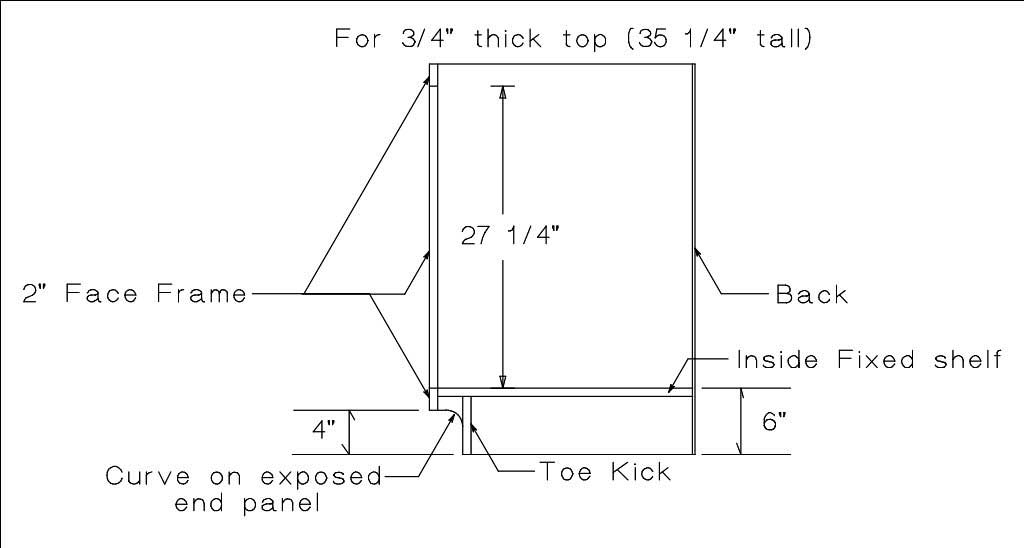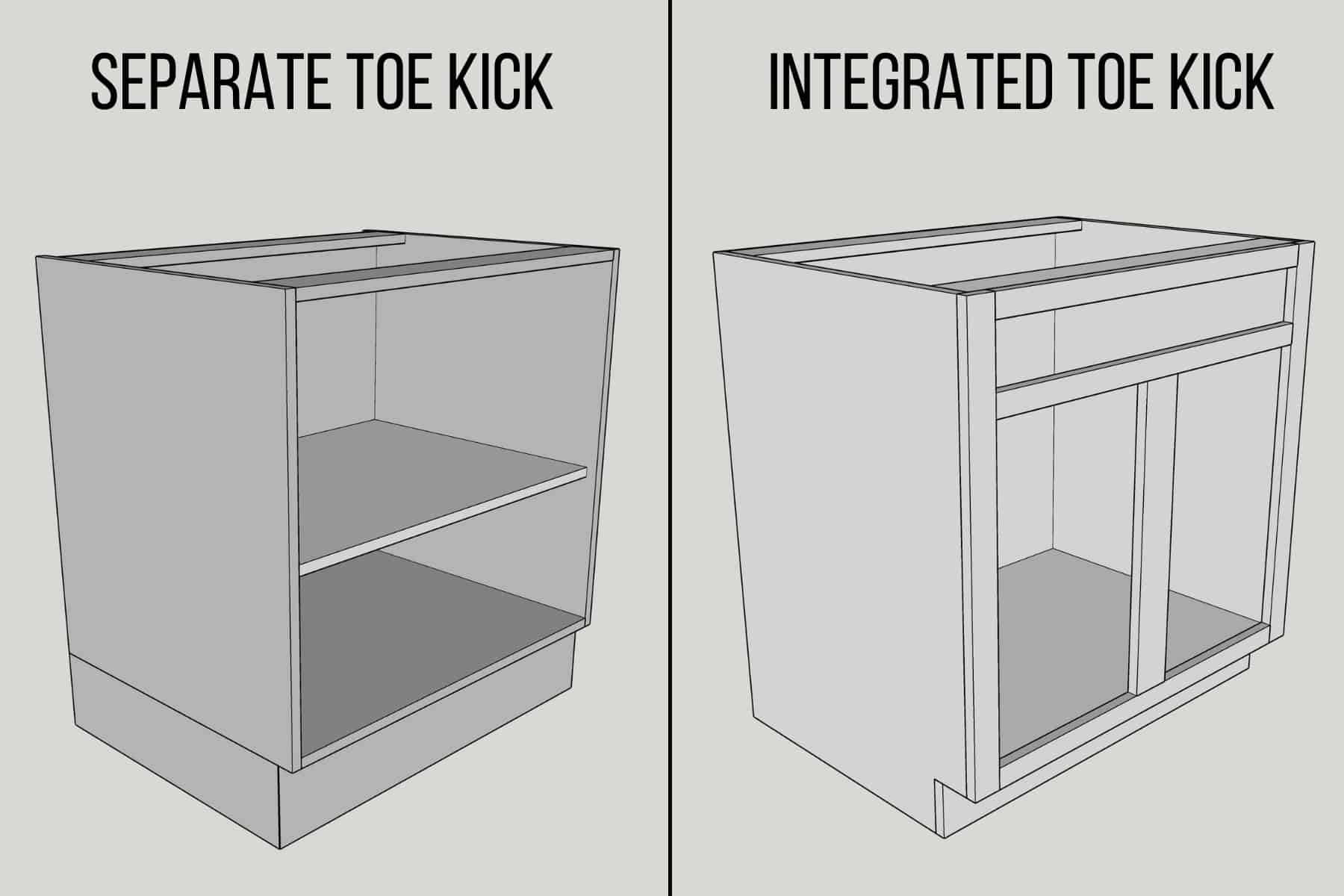Understanding Toe Kick Dimensions: Kitchen Cabinet Toe Kick Dimensions

Toe kicks, the often overlooked yet crucial element in kitchen cabinet design, serve a vital purpose. These hidden compartments, positioned beneath cabinets, provide a practical and aesthetic function.
Standard Toe Kick Height and Depth, Kitchen cabinet toe kick dimensions
The standard toe kick height and depth are crucial for achieving optimal ergonomics and accessibility.
The standard toe kick height is typically 4 inches (10 cm), while the depth ranges from 3 to 4 inches (7.6 to 10 cm).
This configuration allows for comfortable foot clearance while maintaining a stable and aesthetically pleasing base for the cabinets.
Toe Kick Design Variations
Toe kick designs offer diverse options for enhancing functionality and aesthetics.
Open Toe Kicks
Open toe kicks, characterized by their exposed nature, provide unobstructed access to the space beneath the cabinets. This design is often preferred for its ease of cleaning and ability to accommodate various items, such as a trash can or a broom.
Closed Toe Kicks
Closed toe kicks offer a more streamlined and polished appearance. They are typically constructed with a panel that covers the entire toe kick area, creating a seamless look. However, closed toe kicks can limit access to the space beneath the cabinets.
Adjustable Toe Kicks
Adjustable toe kicks offer flexibility and customization. These designs feature adjustable legs or brackets that allow you to fine-tune the height of the cabinets to accommodate individual needs or uneven floors.
Impact of Toe Kick Dimensions on Accessibility and Ergonomics
The dimensions of toe kicks significantly influence the accessibility and ergonomics of a kitchen.
- Height: A toe kick height of 4 inches provides ample clearance for most people. However, individuals with mobility challenges may require a higher toe kick to facilitate easier access to the space beneath the cabinets.
- Depth: A deeper toe kick can provide more storage space, but it may also make it more challenging to reach items placed at the back of the space. A shallower toe kick offers easier access but may limit storage capacity.
Proper toe kick dimensions are crucial for promoting comfortable movement and preventing fatigue during kitchen activities.
Factors Influencing Toe Kick Dimensions

The optimal toe kick dimensions for a kitchen are influenced by a variety of factors, including the style of the cabinets, the type of flooring, and the height of the individuals using the kitchen. Understanding these factors is crucial for creating a comfortable and functional kitchen space.
Impact of Cabinet Style
The style of the cabinets can significantly impact the ideal toe kick dimensions. For example, contemporary cabinets often feature minimalist designs with flush-mounted toe kicks, while traditional cabinets may have more elaborate toe kick designs with decorative molding. The depth and height of the toe kick should complement the overall style of the cabinets to maintain a cohesive aesthetic.
Impact of Floor Type
The type of flooring also plays a role in determining the appropriate toe kick dimensions. Hard flooring materials like tile or hardwood require a higher toe kick to provide adequate clearance for sweeping and vacuuming. In contrast, soft flooring materials like carpet may allow for a lower toe kick.
Impact of Floor Height
The height of the floor can significantly impact the required toe kick dimensions. A higher floor level will require a larger toe kick to ensure comfortable clearance for standing and walking. For example, a kitchen with a raised floor due to a basement or crawl space may require a taller toe kick than a kitchen with a standard floor level.
Impact of Individual Height
The height of the individuals using the kitchen is a critical factor in determining the optimal toe kick dimensions. A taller individual may require a higher toe kick to avoid bumping their knees, while a shorter individual may prefer a lower toe kick for easier access to the cabinets.
It is recommended to consider the average height of the individuals who will be using the kitchen when determining the toe kick dimensions.
Designing Toe Kicks for Functionality and Aesthetics

Toe kicks, the often overlooked element of kitchen design, play a crucial role in both functionality and aesthetics. By thoughtfully considering toe kick dimensions and design, you can enhance storage space, improve accessibility, and create a seamless and visually appealing kitchen.
Maximizing Storage Space and Accessibility
Optimizing toe kick dimensions can significantly increase storage space in your kitchen.
- Maximizing Vertical Space: A deeper toe kick allows for the inclusion of pull-out drawers or shelves, providing valuable storage for pots, pans, and other kitchen essentials. For instance, a toe kick depth of 6 inches or more can accommodate a shallow drawer for utensils or spices.
- Creating Hidden Storage: By incorporating a toe kick drawer, you can discreetly store items that are not frequently used, keeping your countertops clutter-free. This can be particularly useful for storing cleaning supplies, extra dish towels, or even small appliances.
- Ensuring Accessibility: A toe kick height of 4 inches or more provides ample clearance for comfortable access, preventing potential tripping hazards. This is especially important for individuals with mobility limitations.
Blending Toe Kicks with the Overall Kitchen Design
Creating a seamless and visually appealing kitchen requires careful consideration of toe kick design.
- Matching Cabinetry Style: Toe kicks should complement the overall style of your kitchen cabinets. If your cabinets have a modern aesthetic, consider sleek and minimalist toe kicks. For traditional kitchens, opt for more intricate details and moldings.
- Color and Finish: Matching the toe kick color and finish to your cabinets creates a cohesive look. For a subtle and integrated appearance, consider using the same color and finish as the cabinets. Alternatively, a contrasting color can add a touch of visual interest.
- Material Selection: The material of your toe kick should be durable and easy to clean. Common materials include wood, laminate, and metal, each with its own unique properties and aesthetics.
Toe Kick Materials and Properties
Choosing the right toe kick material is essential for durability, maintenance, and cost.
| Material | Durability | Maintenance | Cost |
|---|---|---|---|
| Wood | High | Requires regular cleaning and refinishing | High |
| Laminate | Moderate | Easy to clean and maintain | Moderate |
| Metal | High | Low maintenance | Moderate to High |
Integrating Toe Kick Lighting
Toe kick lighting can significantly enhance both functionality and aesthetics in your kitchen.
- Improved Visibility: Under-cabinet lighting illuminates the work area, making it easier to prepare meals and clean up. Toe kick lighting provides a soft, ambient glow that enhances the overall atmosphere of the kitchen.
- Enhanced Safety: Toe kick lighting helps prevent tripping hazards, especially in dimly lit kitchens. This is particularly important for areas where foot traffic is high, such as near the refrigerator or pantry.
- Aesthetic Appeal: LED strips or puck lights can add a touch of elegance and sophistication to your kitchen design. The soft, diffused light creates a warm and inviting ambiance.
While obsessing over the perfect kitchen cabinet toe kick dimensions, don’t forget the crucial foundation: a good primer for kitchen cabinets. It’s like the groundwork for a political campaign – without it, the whole structure is doomed to crumble.
So, before you start measuring those toe kicks, make sure you’ve got a solid primer in place to ensure your kitchen’s foundation is as sturdy as your political ambitions.
The obsession with standardized kitchen cabinet toe kick dimensions is just another symptom of the larger, insidious trend of conformity. Why should we be bound by the same measurements as everyone else? Perhaps we should take a cue from the 42 inch kitchen cabinets movement, which champions individual expression and breaks free from the constraints of the traditional.
After all, a kitchen is a personal space, and toe kick dimensions should reflect the unique needs and desires of the homeowner, not the dictates of some faceless industry standard.
